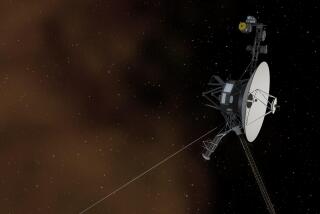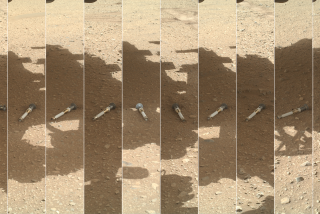Crippled Craft Will Resume Mapping of Red Planet
- Share via
After vain attempts to free a jammed antenna, the Mars Global Surveyor resumes the mapping of the red planet today in an effort to eke out as much of its original mission as possible.
The equipment problems that have crippled the craft’s ability to communicate with Earth could eventually cause the Jet Propulsion Laboratory-run mission to lose half the data it was designed to produce, officials said.
During the next 30 days, mission managers expect to use the surveyor’s six on-board instruments to systematically image the entire orb of Mars in color stereo.
By a stroke of luck, the $250-million spacecraft still will be able to transmit its full scientific findings to Earth until February. During the next nine months, the probe and the planets will continue to be in the right orbital positions for Earth to receive the craft’s high-speed transmissions, although the antenna is stuck.
But mission managers aren’t sure exactly what they will do after February. How much data they wind up losing will depend on how they choose to proceed.
“They are keeping their fingers crossed,” one JPL official said.
Earlier mechanical problems with a solar power panel that cropped up after the craft was launched in 1997 had already delayed the ambitious mapping mission by 18 months and added $11 million to its cost.
Even so, mission planners have collected a trove of technical data about the Martian atmosphere, topography and geologic history, as the damaged craft hovered in orbit around Earth’s mysterious neighbor. The data revealed, among other things, traces of ancient plate tectonics surprisingly like those that drive the movement of continents on Earth today.
The surveyor’s current difficulties stem from a jammed gimbal on the high-speed antenna that prevents the craft from properly tracking Earth as it swings away from Mars during its annual orbit around the sun. The craft needs the antenna to transmit data as fast as it is collected.
“We were in our final mapping position [two weeks ago], with all the instruments pointing at the planet, and then suddenly, when we moved to the next position where the antenna had to move a little more, it stopped,” said project scientist Arden Albee at Caltech. “There is some kind of obstruction that keeps us from having total motion.”
Flight operations manager Joseph G. Beerer at JPL said there were three possible causes of the problem:
A fold of insulating thermal blanket may have fallen into the joint mechanism. A loop of cable may be blocking it. A screw may have unthreaded itself several turns, sticking up just enough to prevent the antenna from swinging freely.
None of those things can be fixed, Beerer said. “I think we are in a situation where we will just have to work with it.”
Consequently, flight controllers can move the antenna to keep it trained on Earth only by moving the entire spacecraft, like a spectator with a stiff neck trying to keep a view of a passing parade. If they move the craft so it points at Earth--as they will have to do after February--they also will swing the instruments out of line with Mars.
To salvage the mission after February, JPL planners and flight controllers at Lockheed Martin Astronautics in Denver are evaluating two plans.
They could tilt the craft slightly to keep the antenna aimed at Earth, while still pointing its instruments down at Mars. That would allow the craft to transmit data continuously, as NASA had intended, but it also would change the spacecraft’s angle of view, affording its instruments only an oblique look at the planet’s surface. That would make it harder to collect the integrated global mapping data that NASA scientists had hoped to gather.
As an alternative, flight controllers could just turn off the mapping instruments periodically and shift the spacecraft to transmit the data to Earth.
That would allow the craft to maintain the same perspective for mapping purposes, but would sharply curtail the amount of data that could be gathered during the mission.
“I think we would not be happy” with either option, said Michael Ravine, advanced projects manager at Malin Space Science Systems in San Diego, which designed and operates the surveyor’s on-board cameras. “It will be a significant reduction in the data we will get back.
“But it would not be the worst thing. Whatever we do get down is definitely going to be worth something,” he said. “And the fact we are in business now means there is some time to find an angle that can be worked out.”
(BEGIN TEXT OF INFOBOX / INFOGRAPHIC)
Struggles of the Surveyor
Despite engineers’ failure to free a jammed antenna, the Mars Global Surveyor is resuming mapping of the red planet. The antenna problem has seriously affected the craft’s ability to communicate with Earth. No one knows what is causing the problem or how to fix it. The antenna may be blocked by a piece of insulation, a loop of cable or even a loose screw.
Source: NASA






